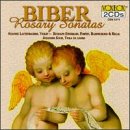| All Artists: Heinrich Ignaz Franz von Biber, Susanne Lautenbacher, Johannes Koch, Rudolf Ewerhart Title: Biber: Rosary Sonatas Members Wishing: 0 Total Copies: 1 Label: Vox (Classical) Original Release Date: 1/1/2000 Re-Release Date: 10/22/1996 Genre: Classical Styles: Chamber Music, Historical Periods, Baroque (c.1600-1750), Instruments, Strings Number of Discs: 2 SwapaCD Credits: 2 UPC: 047163517129 |
Search - Heinrich Ignaz Franz von Biber, Susanne Lautenbacher, Johannes Koch :: Biber: Rosary Sonatas
 | Heinrich Ignaz Franz von Biber, Susanne Lautenbacher, Johannes Koch Biber: Rosary Sonatas Genre: Classical
![header=[] body=[This CD is available to be requested as disc only.]](/images/attributes/disc.png?v=430e6b0a) ![header=[] body=[This CD is available to be requested with the disc and back insert.]](/images/attributes/disc_back.png?v=430e6b0a) ![header=[] body=[This CD is available to be requested with the disc and front insert.]](/images/attributes/disc_front.png?v=430e6b0a) ![header=[] body=[This CD is available to be requested with the disc, front and back inserts.]](/images/attributes/disc_front_back.png?v=430e6b0a) |
Larger Image |
CD Details |
CD ReviewsMagnificent Mysteries Polkadotty | Mountains of Western North Carolina | 07/18/2004 (5 out of 5 stars) "Heinrich Ignaz Franz von Biber (1644-1704), virtuoso violinist and composer, wrote this set of fifteen Mystery or Rosary Sonatas circa 1674. Well respected during his lifetime, Biber served as Kappelmeister at the Salzburg Cathedral under Prince-Archbishop Maximilian Gandolf where he was awarded a title of minor nobility, and was addressed as "Biber von Biber". These sonatas should go a long way in convincing anyone Biber deserved whatever titles he may have earned. Never published during his lifetime ~ scored in tabulature, a form of notation that simply instructs a musician how to place the fingers on the strings ~ written for the violin at a time when this instrument wasn't completely accepted into polite society ~ rife with scordatura, a retuning of the violin from the standard fifths which has been likened to playing blind as the notes sound completely different to the performer's ear than expected ~ this is challenging, moving, thoroughly engaging music. The most extraordinary scordatura tuning occurs in Rosary Sonata XI (The Resurrection), which requires the violinist to interchange the middle two strings, crossing them before the bridge of the violin and again at the nut, resulting in a symbolic cross shape. Each sonata tells a story through various musical means and devices unique to each of the Mysteries: the joyful mysteries (I-V), the sorrowful mysteries (VI-X), and the glorious mysteries (XI-XV). For example, the rapid, swirling figuration that opens the first sonata represents the notion that children are a gift from God. Christ's despair in the garden of Gethsemane is depicted with chromatic ascending and descending lines, a device used by Biber in laments. Repeated notes on the same pitch denote agitation or anger, combined with sharply twisting melodic lines. The violent opening figuration of the tenth sonata is sometimes said to represent the nails being hammered into the cross, while the virtuosic figuration that ends the sonata could represent the earthquake after Christ's death. These specific images enhance the mood of each sonata through careful choice of key, movement type and the scordatura tuning. Of all the available recordings of this work, this one is the most technically pure. Susanna Lautenbacher plays with a confident restraint, allowing the music to speak for itself, and imbues these sonatas with a tangible reverence and spirituality. Here is a recording for anyone who prefers a clean, unhurried approach to baroque music. No flashy fireworks, no fluff, no gilding of the lily ~ no need of it. An interesting aside: The Mystery Sonatas survive in an illuminated presentation manuscript in the Bavarian State Library in Munich, having been donated sometime around 1890 from an anonymous private collection. It's not known who presented the manuscript to the library, nor is anything known of the history of the manuscript before its arrival, or even if it was generally known to have existed. Therein lies another mystery, in and of itself." Strange and Beautiful Pichon14 | Mexico | 02/26/2007 (5 out of 5 stars) "I bought this couple of CDs a long time ago, when this recording was the only CD available on the Biber's Rosenkranz sonaten work. I actually bought this Cds because I was looking for a solo violin work as great as the monumental Ciacona for violin solo of Bach (I have ten different versions of this Bach's work). The only reference to this violin solo works that I could read about at that time was the sonata for the Guardian Angel of Biber. I was exited before hear it, but in that time I hear briefly and I was not pleased for what I heard. I don't give to my ears and brain and my soul a chance to hear it. And I store the CDs for years. Then I try to hear again the Sonates, about 5 years later, I was curious, trying to rediscover some CDs that I never heard as I must had to. And wow! These Rosenkranz Sonaten are some of the most beautiful and original works for violin I have never heard. The performers record this works on the early 60's, this year get to 45 years old the recording, a lot of time. Mrs. Lautenbacher plays beautiful, gently, softly, may be she was not a violin virtuoso as Mr. Heifetz was, but play this music with taste and soul. I like specially a lot the sonatas 10 and the 15 and the 21 (yes the great passacaglia).
After this Biber become one of my predilect composers as is J.S.Bach, some of his sons, and many others. But Biber is one on the top on my preference list with few others." |

 Track Listings (24) - Disc #1
Track Listings (24) - Disc #1